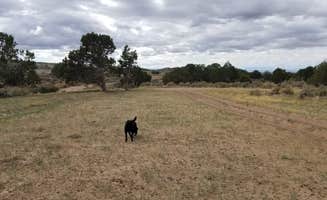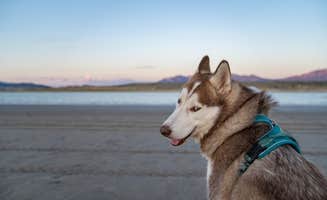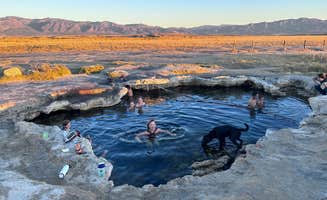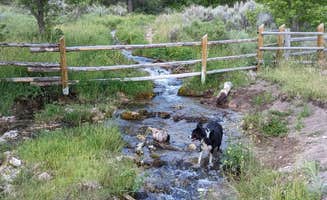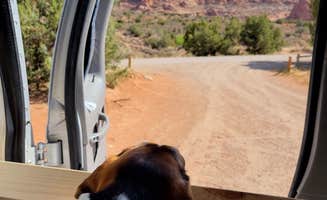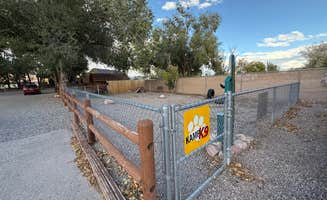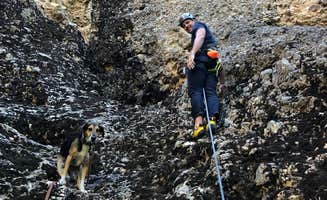Dispersed camping areas near Delta, Utah provide accessible options for overnight stays in the high desert environment. Most sites sit between 4,500-5,000 feet elevation, with daytime temperatures often exceeding 90°F during summer months. The terrain transitions from desert valleys to juniper forests as you travel east from Delta toward the Fishlake National Forest boundaries.
What to do
Wildlife viewing: 2 miles from trailhead. West Fork trail offers excellent wildlife spotting opportunities without extensive hiking. "You can park at the trailhead and hike up only 2 miles before you start seeing deer and elk everywhere. You simply follow the river up the canyon, and choose from any of the small flat locations for tent camping," notes one visitor to West Fork - Whiskey Creek Dispersed Camping.
Cave exploration: accessible year-round. The lava tubes near Pahvant Valley provide unique camping experiences with natural temperature regulation. "This is a primitive spot no tables or fire pits. You can camp in the lava tube they are warm in the winter and it is a fun place to explore," writes a camper at Pahvant Valley Heritage Trail Dispersed.
Hot springs access: nearby. The Pahvant area connects to thermal features popular with campers. "Very unique and cool spot. Close to hot pots and great hiking areas," notes another Pahvant Valley visitor.
Creek wading: seasonal water flow. Oak Creek offers water features for cooling off during hot months, though flow varies by season. "Located in a quiet area with plenty of shade. Nice pavilion and pretty clean grounds," reports a summer visitor.
What campers like
Solitude: minimal neighbor interaction. Many dispersed sites around Delta provide isolation from other campers. "Only one other camper has been here in the 5 days that I have been here so far. There are any number of spots along this road that could be used for dispersed camping," notes a reviewer at Whiskey Creek Road - Dispersed Site.
Cell service: unexpected coverage. Despite remote locations, some sites maintain connectivity. One camper at Fish Lake National Forest Campsite reports, "I could hear some road noise, but had 3+ bars of T-mobile 5g service. Not another person in sight except for maybe 2 cars that drove by during the night."
Shade availability: juniper trees. Tree cover provides relief from summer heat. "Super easy access for any car if roads are dry. Lots of places to get back in the junioers a lil and have a nice private place to sleep," notes another Fish Lake National Forest visitor.
Established fire rings: most sites. Many dispersed areas have existing fire containment. "A number of fire pits exist in this area. It is readily apparent that others have stayed here in the past," reports a camper.
What you should know
Road conditions: variable by season. Access to dispersed sites can deteriorate after rain. "The drive in past the pavement was dusty, but not horrific. The road had been graded so there a lot of rocks on the surface of the road. No washboard," reports a camper at Pahvant Valley.
Water availability: limited sources. Most dispersed sites lack water access. "In the summer months, water is scarce so bring water. If the creek is full and running you can simply filter water," advises a West Fork visitor.
Livestock presence: expect company. Free-range cattle frequently share camping areas. A camper at Dispersed West Fork 8 Mile Road notes, "I found a spot on Eight Mile road, just off i-15, near the east side of the national forest. Not another person in sight except for maybe 2 cars that drove by during the night. Plenty of cows and cow patties around though!"
Fire restrictions: seasonal changes. Check current regulations before planning campfires. "There is a lot of fallen pine and juniper wood there to use for building fires. Just remember to drown out your fires with water," advises a Fish Lake camper.
Tips for camping with families
Kid-friendly hiking: age-appropriate trails. Younger children can manage some local trails with proper planning. "Was able to hike in with my 8 year old, and he loved it. Great secluded dispersed spot for wildlife watching," shares a West Fork visitor.
Dog-friendly areas: voice control needed. Most dispersed camping near Delta welcomes pets, especially along Eight Mile Road where open spaces provide room for dogs. "Stopped for the night no WiFi, loud highway noise, no grass nothing for dogs, nothing for kids," cautions one reviewer about Antelope Valley RV Park, suggesting dispersed options might work better for families with pets.
Space for exploration: natural playgrounds. Children can safely explore certain areas with supervision. "Kids enjoyed exploring and climbing the small trees. Previous campers made fire pits. No one to be seen for miles," notes a family at Whiskey Creek Road.
Camping on a budget: free options. Many dog-friendly campgrounds near Delta cost nothing. "This is a large, nicely kept, clean RV park with water, electrical 30 amp and 50 amp and sewer. Showers are available at no cost and laundry is available for $2.50 per wash and $2.50 per dry," notes an Antelope Valley RV Park visitor describing a paid alternative.
Tips from RVers
Size limitations: dispersed areas. Most off-grid sites accommodate smaller rigs. "Campers, RVs, and people with tents can easily use this site. No facilities," notes a reviewer about Sandy Lot dispersed camping.
Hookup options: limited outside parks. For utilities, established campgrounds are necessary. "The biggest problem is using the laundry. It's necessary to download an app which is complicated and irritating then you have to load the app with money," reports an Antelope Valley visitor.
Campsite selection: road clearance. Some roads narrow significantly. "The farther you go along the road the rougher it gets," warns a camper about Whiskey Creek Road.
Level parking: search required. Finding flat spots for trailers requires scouting. "The campsite was fine. Just a few trees to keep us company. Bronco towing a Lance 1475," notes a camper describing their setup at Oasis Campground — Yuba State Park.


